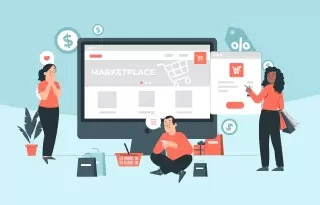Subscribe and you will promptly receive new published articles from the blog by mail
Cross-border eCommerce is the future of online shopping. There is no denying it as you can hardly find someone who wouldn’t want to buy goods directly from the manufacturers. Customers would prefer to avoid any anxieties and problems on the border. This is why online shopping is going to surpass international boundaries.

During the last 20 years, we have been witnessing the eCommerce revolution. Due to its impact, the industry has been growing and evolving.
Today, we live in the age of global manufacturing. Most companies and corporations try to produce their goods in those countries where this process is the cheapest and export them all over the world.
The delivery stage depends heavily on the demand forecast and importers’ partnership terms. Once research is done and agreements are signed, the salesmen or importers make lists of their stock on eCommerce portals and traditional brick-and-mortar stores.
In fact, it doesn’t matter whether you buy online or offline. In most cases, the things that you buy pass the cross-border control. Products pass through the hands of brokers and middlemen before you get to buy them. Furthermore, every middleman has to make a profit to keep operating, so such companies take fees and drive up the price for you, the end customer.
Due to all of this, the long process of goods delivery impacts the products’ prices. Storing the goods under appropriate conditions also increases the seller’s expenses, so the price for end customers is getting even higher.
There is a whole other issue with clothes. It takes a few months to receive a long-awaited shirt or skirt. While your package is stuck at the border, designers create something new. Therefore, you will receive an outdated item you won’t be able to enjoy. Besides, the range of products which are available to you in traditional stores is based on the generalized choice of the whole population of the area. So, unfortunately, it may be hard to find items that reflect your individuality.
Long story short, as a result, you end up looking at your outdated purchase which is not your cup of tea, you don’t know what to do with it, and because you paid an arm and a leg for it.
Cross-border eCommerce is a long and complicated process due to:
- high international payments;
- costly international logistics;
- bureaucratic customs procedures;
- risks of stealing and fraud.
However, over the past few years, there has been some improvement in the whole situation. For instance, technological progress and policy changes contribute to more businesses operating in the cross-border eCommerce industry.
This is why the cross-border B2C eCommerce business model (CBB2C) is noticeably evolving and becoming more popular. So, it would be fascinating to see how eCommerce will transform in the nearest future, especially considering that the eCommerce trade indicators keep rising.
eCommerce Trends
From offline to online – this is the main trend of our time. Today, we are living in the age of mobile devices. More and more people use different types of smart devices on a daily basis. So, more and more companies, in their turn, strive to adapt to their potential and existing customers’ preferences and reach more people. This is why they invest in creating mobile apps for their businesses. A successful app can increase sales and, therefore, profit – and what business wouldn’t want that?
Recently, consumer behavior has changed – people use their smart devices and the Internet more often than they used. According to the latest Google data, on average, people use their phones nearly 160 times per day.
Some believe that the future of eCommerce is its complete assimilation with all aspects of our lives. Ultimately, you will be able to order anything you want, wherever you want.
At some point, humanity will look back, and nobody will even imagine what life was like without smartphones and other advanced technologies. eCommerce is the first step towards such a future – it is already changing our traditional process of shopping. For example, if you don’t like to go shopping, you can buy everything you need directly from the warmth of your house and get your ordered goods right at the doorstep.
According to statistics, more than 62% of US shoppers buy online at least once per month, and an eighth of the buyers stay content with such an experience.
Clearly, eCommerce is developing, and it is doing this rapidly. It is predicted that in 2019 its market share will extend up to 11.9%. For comparison, ten years ago, this indicator was just 3.5%. The combination of such a rapid increase and a relatively low market share creates great opportunities for beginning sellers.
The Internet Instead of Department Store

Nowadays, retail trade is clearly experiencing radical changes. However, these changes are not just about technology. There are new business models appear every now and then – and they influence the eCommerce industry and impact purchasers’ behavior and expectations.
Our generation got used to going to department stores. Why? Because we think that a department store is where you can buy various types of goods, all in one place. Obviously, it was a perfect decision for many people to shop there – until now.
However, if we think about it a bit more, we will see that energy and time are two very scarce resources for an average person today. So, the retail business should be looking for ways to make shopping fast and easy.
Online Retail Will Diminish the Need for Offline Stores

Can you name any great and competitive offline stores that don’t offer online shopping services as well? No? Well, it’s no surprise – it really is difficult to find such a store nowadays. The reason is that in the age of worldwide globalization, there is a rule – offline stores that aren’t online are not trustworthy. Nobody will believe that they exist and they are not frauds!
Hence, in the near future, online eCommerce stores are going to gain more and more new buyers among Internet users while offline ones are going to have to refocus on providing their products or services online. In fact, many offline store companies have already started to attract new clients by offering them more opportunities and goods online.
What Is Mobile eCommerce (M-Commerce)?

Smart devices are becoming lighter, smaller, and handier. It is a huge opportunity for M-Commerce.
Our mobile phones are excellent devices for communication, and of course, surfing the Internet or online shopping. Many young people get shocked and sometimes even nervous when they can’t find the mobile version of a particular website. And some think this is just the start of mobile phones taking over our lives.
What does it mean for the eCommerce industry? M-Commerce is going to get only more popular among consumers. And who knows – maybe, shopping on your smartphone will become more common than using the desktop version of the website or going to a brick-and-mortar store.
Social Media Is a Key Driver of eCommerce

For many years, traditional advertising played an essential role in businesses’ success or failure. However, the situation has changed. Today, when billboards, promos, and targeted ads are everywhere, the advertisement itself has lost its force.
So, nowadays, people use ad blockers and feel numb to regular ads. Instead, they look for authentic reviews and recommendations. Besides, they seek direct communication channels with the brands. Consequently, social media is a modern fundamental tool for promoting your products in a more efficient way and a new magic spell for the rapid development of eCommerce businesses.
The inevitable change is right here and right now. Social media has changed how we communicate, search for, and purchase products. So, every business that embraces the spirit of change is bound to achieve commercial success and huge profits.
eCommerce Personalization
Let’s take a look at the USA. Today, eCommerce is the main driving force of all the progress in the retail industry, and the situation is not going to change any time soon – more and more people prefer to shop online.
In the future, the crowning achievement for eCommerce businesses will be the excellent personalization that will increase the number of regular customers. Certainly, it will be very arduous to retain customers under the conditions of ever-widening competition. Finally, customers will opt for those online shops that provide not only the goods they need but also the best customer experience. This is why successful eCommerce retailers are already striving to make things more touchable and realistic on the web.
Many businesses try to find some way to bring together their real-life and online customer experience and make it consistent. They want to blur the line between eCommerce and brick-and-mortar commerce.
For instance, now the retail business is combining online tracking and real-world customer information. This can be a big advantage for customizing the shopping experience, as we have mentioned above. Furthermore, this allows retailers to use online data to personalize their whole online and offline customer experience.
Just think about it – we use the Internet every single day. We never abstain from it. Positively, everything we need, want, or think about is one tap away. eCommerce is surely an excellent thing that provides a broad spectrum of opportunities for any business. Moreover, it provides customers with all the information they need to make a balanced choice.
So, as it always is in the competing business world, time is money, and there can be nothing more precious than time. And eCommerce stores have a vast advantage over the traditional brick-and-mortar ones in this respect. Why? When you need to buy something online, it takes you just a few clicks. From a business perspective, eCommerce reduces the expenditures related to middlemen services which allows you to offer your goods at a lower price or use the saved resources for enhancing your business.
Thanks to the Internet, customers have access to secure payments through the integrated fee portals. People can get a package right on their threshold, without having to leave their house. This is convenient not only for customers but for businesses as well.
Thanks to eCommerce, doors all over the world have opened for numerous businessmen and investors. The face of the worldwide economy has changed, and tomorrow looks bright and light!

Drone delivery may be one of the most impressive trends in eCommerce development. It has already been tested by some leading eCommerce corporations.
In the near future, drones will deliver packages efficiently and expeditiously. The delivery time can be reduced from 30 minutes to one hour thanks to such astounding technological development. Imagine drones take off from the warehouses and land right at the given delivery addresses.
Unmistakably, drone delivery is available at a lower cost and with less logistical nightmares than the delivery approaches used now. In all seriousness, such an eCommerce shark as Amazon is aiming to make this idea come true. Consequently, others will follow suit to catch up as fast as possible.
eCommerce Will Take the Lead in the Nearest Future
There are a few areas in which eCommerce will advance in the near future:
- absolute personalization;
- rapid delivery;
- instant customization;
- e-wallets with digital payments;
- eCommerce will merge with many technologies, and these technologies will transform the industry.
The main technologies that major big companies are investing in to take advantage of these advancements are:
- the Artificial Intelligence technology;
- the Augmented Reality technology;
- the drone delivery technology;
- the social commerce technology;
- connected devices;
- digital wallets;
- chatbots;
- Big Data.
These technologies where major implementation aim is to increase and improve the interaction between eCommerce businesses and their customers. Furthermore, all these technologies will create numerous touchpoints for these two parties and, therefore, make eCommerce an integral part of people’s lives.
Shopping will not remain a routine – all of these technologies will transform it into an outstanding experience and integrate eCommerce into our lives.
Marketplace of the Future

In case you really want to shine in the eCommerce industry, you should build your store based on the technologies that can lead and support multichannel retail with the smallest hand-operated data from you.
There are several things you need to pay special attention to if you are going to launch your own eCommerce store:
- market discoverability;
- market integrations;
- online payments;
- user experience.
Now, let’s take a look at several platforms that can help you create a marketplace of the future.
Sharetribe
Sharetribe is one of the best platforms for developing and launching a marketplace with numerous vendors in a matter of minutes. In this case, the marketplace gives sellers an opportunity to offer goods or services online without any special technical support.
One of the main advantages of Sharetribe is that you can build your own online marketplace in a matter of several clicks. Moreover, simple customization tools allow reflecting your brand in the marketplace. It is important to emphasize that you can get the commission fees from the vendors that you provide with a spot on your online marketplace.
Furthermore, Sharetribe allows buyers to pay online. It accepts all kinds of digital payments. Order management and interacting with customers are easy-to-use.
Cocorico
Cocorico is a great option for marketplaces in the field of in-service and rent, like Airbnb or Blablacar. The main difference between Sharetribe and Cocorico is that the latter one focuses on building service-based marketplaces.
Cocolabs created Cocorico for two main reasons. First of all, they needed a suitable open-source solution. They wanted to use it to build complex marketplaces for their clients. Secondly, they wanted to make their marketplaces distinguishable from usual SaaS solutions.
Using Cocorico, you get some outstanding features that all huge marketplaces can benefit from, such as dynamical calendar, administration tools, charging shoppers and salesmen, etc.
So, if you want to build marketplaces in the field of in-service and rent, Cocorico will be the best platform for you, especially if you would like to have total control over the marketplace’s functionality and take advantage of one of the best-developed modules out there. At the moment, Cocorico is available as a custom service, but Cocolabs is going to launch it as a hosted service as well.
Opencart Marketplace
Opencart Marketplace is a marketplace module designed by Opencart. It allows customizing the marketplace’s features and offers out-of-the-box solutions. It can turn a simple store into a huge marketplace.
Opencart Marketplace has a special agent that can provide replies. The module includes delivery management. Using Opencart Marketplace, sellers can manage their package transportation and calculate the weight of the package and price of the delivery. Besides, customers can view detailed information about the salesman. Thanks to all these features and more, Opencart Marketplace is a full-fledged platform for creating an amazing online marketplace.
Conclusion
Nowadays eCommerce is becoming more and more popular. We can experience its benefits any day. We can easily buy anything we want or need by making a few clicks or taps. eCommerce is a simple way to satisfy our needs.
Unmistakably, the eCommerce industry has a great future ahead of it. If you are a part of it, your business has to keep being focused on customers’ preferences and needs. Special offers, discounts, and new technological advancements can draw people to one company or another. It is simple as that – when companies will work according to customers’ needs, their eCommerce indicators will keep growing.
Online marketplaces are an excellent way to help buyers and sellers find one another. On such marketplaces, sellers should be working according to customers’ needs.
There are three main advantages of the marketplace for all the parties involved:
- As for customers, marketplaces give them a hugely better capacity to compare the stores, their prices, and products’ quality;
- As for the marketplace owner, delivery allows introducing a zero-stock policy, so you don’t need to deal with the logistics;
- As for the vendors, they can concentrate on improving their products and services instead of the selling platform.
To sum up, multi-vendor marketplaces do not supersede eCommerce but rather enhance it and provide more opportunities for eCommerce businesses. So if you want to create marketplace – get in touch!
Recommended articles
 Key Trends in Marketplace Development in 2025 [Updated]
Key Trends in Marketplace Development in 2025 [Updated]The online marketplace ecosystem is undergoing a major transformation, with new technologies and shifting consumer demands paving the way. What will drive success in 2024/25? Find out in this deep dive into the trends.
 Cross–border e-commerce: the future of online selling?
Cross–border e-commerce: the future of online selling?Global shopping is no longer a luxury—it’s the new norm. Cross-border e-commerce is revolutionizing how businesses connect with customers worldwide, breaking down traditional barriers to trade. But what’s driving this shift?
 Why Cryptocurrency Payments Are the Future of Your Online Marketplace
Why Cryptocurrency Payments Are the Future of Your Online MarketplacePayment systems evolve along with new emerging human needs and wishes. The cryptocurrency boom is already changing the face of the e-commerce industry as we know it, creating many opportunities for entrepreneurs.
 How Blockchain technology affects future online marketplaces
How Blockchain technology affects future online marketplacesOver the past couple of decades, online marketplaces have provided the basis for some of the biggest success stories in business. But as with anything that seems so perfect, all this should lead us to ask: how long can all this last?






